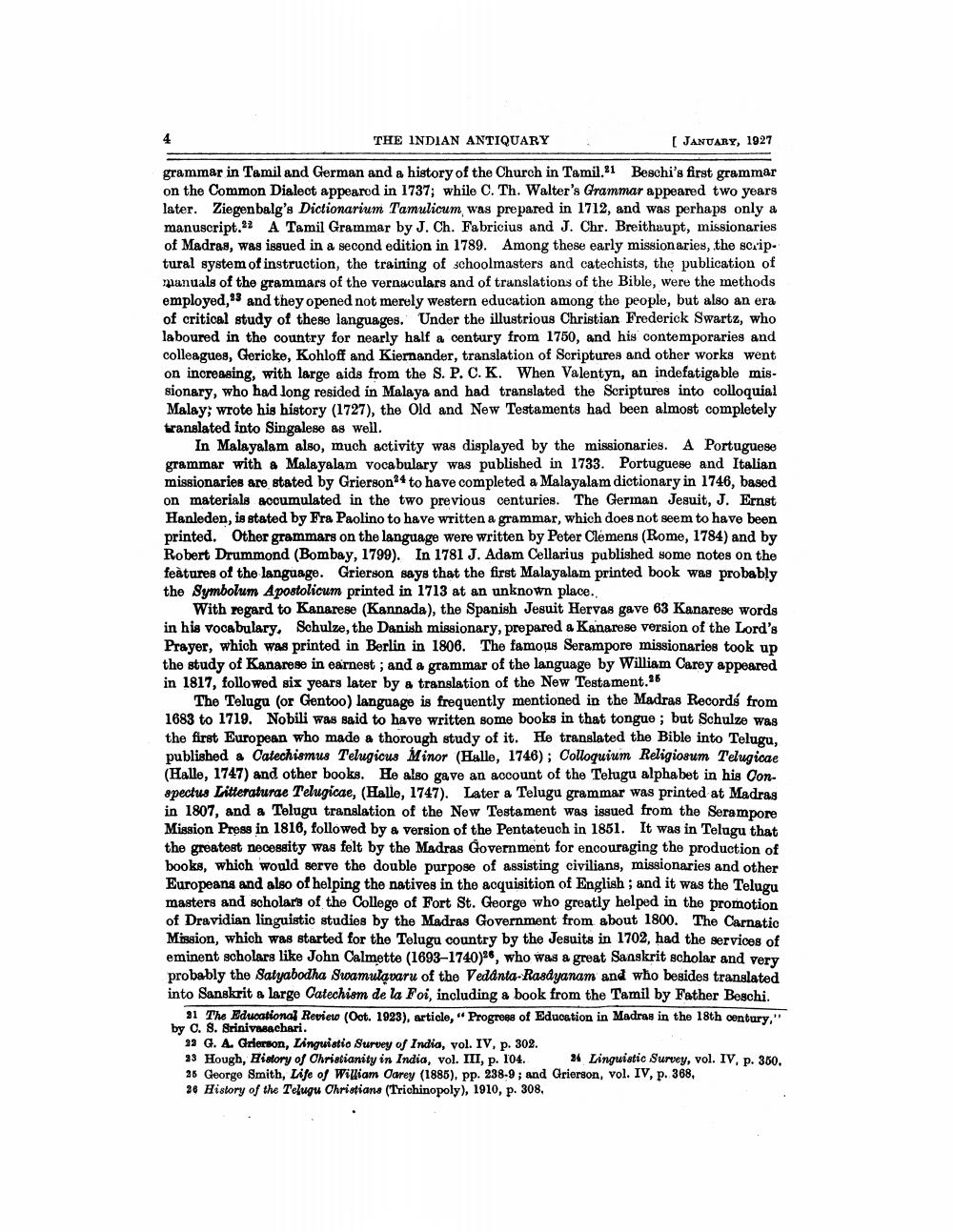________________
THE INDIAN ANTIQUARY
[ JANUARY, 1927
grammar in Tamil and German and a history of the Church in Tamil.21 Beschi's first grammar on the Common Dialect appearod in 1737; while C. Th. Walter's Grammar appeared two years later. Ziegenbalg's Dictionarium Tamulicum was prepared in 1712, and was perhaps only a manuscript.22 A Tamil Grammar by J. Ch. Fabricius and J. Chr. Breithaupt, missionaries of Madras, was issued in a second edition in 1789. Among these early missionaries, the scrip. tural system of instruction, the training of schoolmasters and catechists, the publication of manuals of the grammars of the vernaculars and of translations of the Bible, were the methods employed, and they opened not merely western education among the people, but also an era of critical study of these languages. Under the illustrious Christian Frederick Swartz, who laboured in the country for nearly half a century from 1750, and his contemporaries and colleagues, Gericke, Kohloff and Kiernander, translation of Scriptures and other works went on increasing, with large aids from the S. P. C.K. When Valentyn, an indefatigable missionary, who had long resided in Malaya and had translated the Scriptures into colloquial Malay; wrote his history (1727), the Old and New Testaments had been almost completely translated into Singalese as well.
In Malayalam also, much activity was displayed by the missionaries. A Portuguese grammar with a Malayalam vocabulary was published in 1733. Portuguese and Italian missionaries are stated by Grierson®4 to have completed a Malayalam dictionary in 1746, based on materials accumulated in the two previous centuries. The German Jesuit, J. Ernst Hanleden, is stated by Fra Paolino to have written a grammar, which does not seem to have been printed. Other grammars on the language were written by Peter Clemens (Rome, 1784) and by Robert Drummond (Bombay, 1799). In 1781 J. Adam Cellarius published some notes on the features of the language. Grierson says that the first Malayalam printed book was probably the Symbolum Apostolicum printed in 1713 at an unknown place.
With regard to Kanarese (Kannada), the Spanish Jesuit Hervas gave 63 Kanarese words in his vocabulary, Schulze, the Danish missionary, prepared a Kanarese version of the Lord's Prayer, which was printed in Berlin in 1806. The famous Serampore missionaries took up the study of Kanarese in earnest ; and a grammar of the language by William Carey appeared in 1817, followed six years later by a translation of the New Testament.36
The Telugu (or Gentoo) language is frequently mentioned in the Madras Records from 1683 to 1719. Nobili was said to have written some books in that tongue ; but Schulze was the first European who made a thorough study of it. He translated the Bible into Telugu, published a Catechismus Telugicus Minor (Halle, 1746); Colloquium Religiosum Telugicae (Halle, 1747) and other books. He also gave an account of the Telugu alphabet in his conspectus Litteraturae Telugicae, (Halle, 1747). Later a Telugu grammar was printed at Madras in 1807, and a Telugu translation of the New Testament was issued from the Serampore Mission Press in 1816, followed by a version of the Pentateuch in 1851. It was in Telugu that the greatest necessity was felt by the Madras Government for encouraging the production of books, which would serve the double purpose of assisting civilians, missionaries and other Europeans and also of helping the natives in the acquisition of English ; and it was the Telugu masters and scholars of the College of Fort St. George who greatly helped in the promotion of Dravidian linguistic studies by the Madras Government from about 1800. The Carnatic Mission, which was started for the Telugu country by the Jesuits in 1702, had the services of eminent scholars like John Calmette (1693-1740)26, who was a great Sanskrit scholar and very probably the Satyabodha Swamulavaru of the Vedanta- Rasdyanam and who besides translated into Sanskrit a large Catechiom de la Foi, including a book from the Tamil by Father Beschi.
91 The Educational Review (Oct. 1923), article, " Progress of Education in Madras in the 18th century," by C. S. Srinivasachari.
32 G. A. Grierson, Linguistio Survey of India, vol. IV, p. 302. 33 Hough, History of Christianity in India, Vol. III, p. 104. 4 Linguistic Survey, vol. IV, p. 360. 26 George Smith, Life of William Carey (1885), pp. 238.9; and Grierson, vol. IV, p. 368. 36 History of the Telugu Christians (Trichinopoly), 1910, p. 308.




